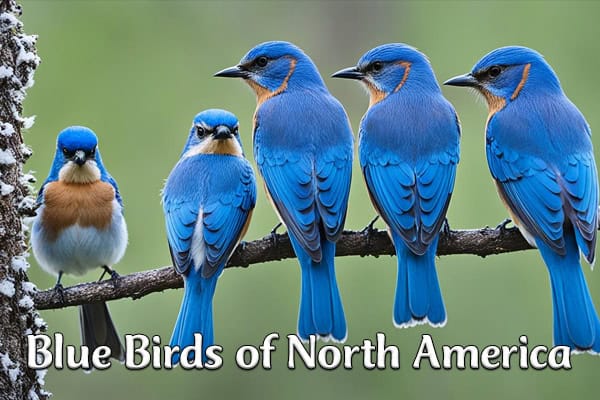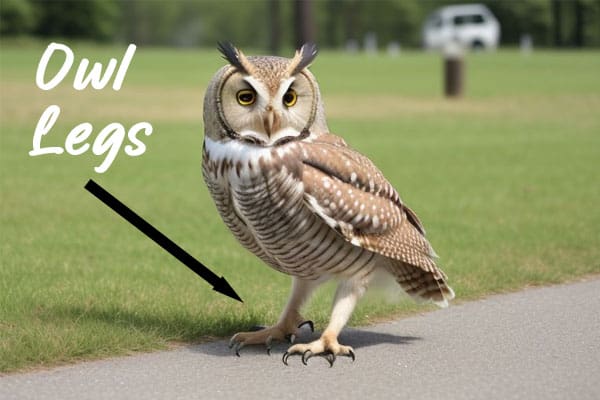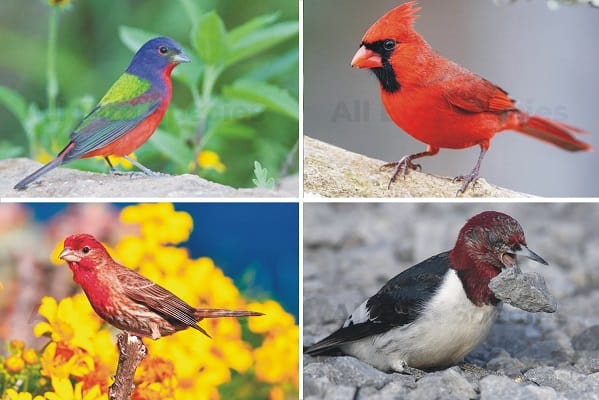Blue Birds of North America (11 Species With Photos)
Blue Birds of North America are some of the most beautiful birds with their bright blue feathers. I’ve looked into their colors, behaviors, songs, and how they migrate. Also, we’ll meet the Eastern Bluebird and the Blue Jay. These birds are colorful and have interesting habits.
So, let’s dive into their world and see what makes each one special and why they’re important to our environment.
~Here we’ll discuss 11 Blue Birds That Live in North America~
Blue is a rare color in nature, making blue birds truly special. North America is home to many blue birds with different colors, intensities, and habitats. This section will introduce you to some common blue birds found in North America.
Overview of Common Species
The Western Bluebird is a standout in the west, known for its blue plumage and rusty orange chest. The Indigo Bunting is famous for its deep cobalt color. The Eastern Bluebird is loved for its bright colors and happy song.
The Blue Jay is known for its bold look and smarts. The Cerulean Warbler is small but important, living in old forests. The Blue Grosbeak is a sight to see, with its bright male plumage, found in the southern U.S.
Don’t forget the Little Blue Heron, a bird of wetlands with a diverse habitat. The Florida Scrub-Jay is unique to Florida but is in danger due to habitat loss. Exploring North American blue birds reveals their interesting behaviors and the beautiful places they live.
1. Eastern Bluebird (Sialia sialis)
The Eastern Bluebird, known as Sialia sialis, is a beautiful bird with bright blue feathers and warm orange underparts. It’s loved for its looks and important role in nature. We’ll look into how to spot it, where it lives, and what it eats.

Identification and Characteristics
Spotting the Eastern Bluebird is a joy for bird lovers. They are 16 to 21 cm long, with a wingspan of 25 to 32 cm, and weigh 27 to 34 grams. There are eight subspecies, each with its own color variations, making them even more interesting.
Habitat and Distribution
The Eastern Bluebird likes open fields, orchards, parks, and cities with trees. They live mainly in eastern North America, from southern Canada to the Gulf states, and into Mexico and Central America. They need places with trees for perching and nesting, and where they can hunt for insects.
Diet and Feeding Habits
The Eastern Bluebird eats mostly insects, like beetles, crickets, and caterpillars, in the summer. In winter, these blue birds of north america eat wild fruits like blackberries and grapes. They help control pests, which keeps nature in balance.
2. Western Bluebird (Sialia mexicana)
The Western Bluebird is a bird with bright dark blue feathers and a warm orange chest. It’s easy to distinguish males from females and young ones. Males have a bright blue throat. Females and young birds often have bright gray-blue feathers above and a pale chestnut breast, seen in about 80% of them.

These birds are between the size of a sparrow and an American Robin. Adults are 15 to 18 cm (5.9 to 7.1 in) long and weigh about an ounce.
Identification and Characteristics
Identifying the Western Bluebird means looking at the differences between males and females, and young birds. About 60% of them are males, showing off their bright colors. Adults have blue feathers, especially on their throat, making them stand out in different places.
Thanks to conservation efforts, this bird is listed as “Least Concern.” Their numbers are stable and they live in many places.
Habitat and Distribution
You can find Western Bluebirds in open woodlands, backyards, farmland, and areas recovering from fires. They live in places like California, the southern Rocky Mountains, Arizona, and New Mexico, and even in parts of Mexico. They like to nest in tree holes or nest boxes, competing with other birds for these spots.
The type of place they live in affects how well they do. Forests that have been restored are better for them, helping more young birds survive.
3. Mountain Bluebird (Sialia currucoides)
The Mountain Bluebird is a beautiful bird known for its bright blue feathers. It lives in western North America. This bird is easy to spot because of its unique look and where it likes to live.

Identification and Characteristics
Adult male Mountain Bluebirds in North America have bright blue feathers, darker on their back and lighter on their belly. Females and young birds are mostly gray-brown with a bit of pale blue in their wings and tails. Young birds look like females but have more spots on their backs and bellies.
Their black bill is a key way to tell adult males apart. In winter, these males might look paler, especially around their bellies. They are bigger than a Cassin’s Finch but smaller than an American Robin, making them interesting to watch.
Habitat and Migration Patterns
Mountain Bluebirds live in open areas like prairies, sagebrush steppes, and alpine tundra. They like to hover and catch insects from high spots. In the winter, they gather in big groups to eat berries, especially from junipers.
These birds move north for the summer and south for the winter. Most live in the U.S., but some breed in Canada and winter in Mexico. Watching them migrate is a colorful event in different landscapes.
4. Blue Grosbeak (Passerina caerulea)
The Blue Grosbeak is a bird with striking blue feathers and a big size. It’s easy to spot because of its bright colors, especially in males. They have deep blue feathers, chestnut wing bars, and a black mask.

Females look different, with rich cinnamon-brown feathers. Young Blue Grosbeaks look like adult females but have a dark chestnut color.
Identification and Characteristics
Male Blue Grosbeaks are known for their beautiful songs. They sing from trees and wires. They are bigger than Indigo Buntings but smaller than Brown-headed Cowbirds.
They often raise two broods of young in a season. This shows how well they adapt and thrive in different places.
Habitat Preferences
These birds like to live in areas with grasslands, forbs, and shrubs. They need a few tall trees too, especially in dry places. They build their nests low in trees, shrubs, or vines, often near roads and open areas.
They are found all over the southern U.S., but they’re not very common. In recent years, they have moved further north.
Dietary Habits
Blue Grosbeaks eat insects and seeds. Their diet changes with the seasons to fit their environment. Many of them move south for the winter, while others cross the Gulf of Mexico.
5. Indigo Bunting (Passerina cyanea)
The Indigo Bunting, known as Passerina cyanea, is a bird that catches the eye in North America’s skies. In summer, males show off a bright blue color. This stands out against the brown of the females. Learning how to spot this bird can make birdwatching more exciting and help you appreciate nature more.
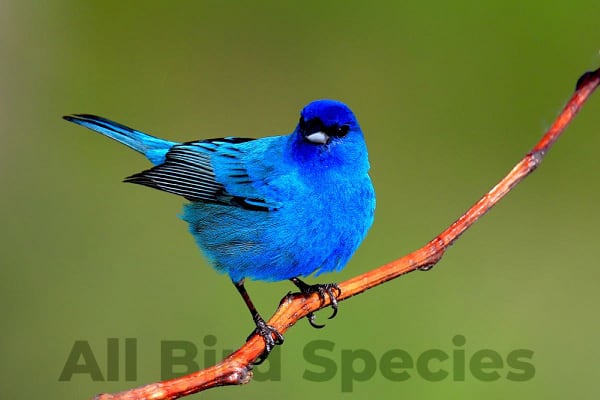
Identification Features
This small songbird, about 11.5–13 cm (4.5–5.1 in) long, is easy to spot in the summer. Males have a bright blue color that’s not from pigments but from how light interacts with their feathers. Females, however, have a brown color that blends in with their surroundings.
Summering and Wintering Grounds
Indigo Buntings live in eastern North America during late spring and summer. They like areas with lots of bushes. They can be found from southern Canada to the eastern parts of Florida and Texas, and even as far west as southern Nevada.
These blue birds of north america migrate at night to Central America and the Caribbean for the winter. Scientists have studied how they use the stars to find their way during these long journeys.
7. Steller’s Jay (Cyanocitta stelleri)
The Steller’s Jay is a standout bird in western North America’s forests. It’s easy to spot because of its black and blue feathers. You can see it in parks and campgrounds, making it common in many backyards.
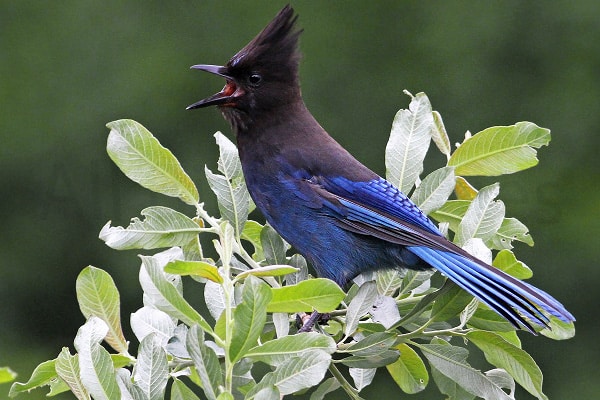
Identification and Characteristics
This bird is as big as a Western Scrub-Jay, measuring 30–34 cm (12–13 in) long and weighing 100–140 g (3.5–4.9 oz). Its feathers are a mix of black and blue, covering its head and body. There are 16 types of Steller’s Jays, each with its own look.
For example, Pacific Jays have darker feathers with blue streaks near their eyes. Meanwhile, Rocky Mountain Jays have lighter feathers with white streaks and a white ring around their eyes.
Steller’s Jays are not just beautiful but also bold and curious. They love to explore and are very smart. They make a lot of noise and fly steadily while looking for food on the ground. Their diet includes plants and animals, like seeds, nuts, berries, and small rodents.
8. Blue Jay (Cyanocitta cristata)
The Blue Jay is known for its bright blue feathers and smart behavior. It lives in the eastern United States, near forests, woodlands, and even in cities. Bird lovers love to watch it because of its beautiful colors.
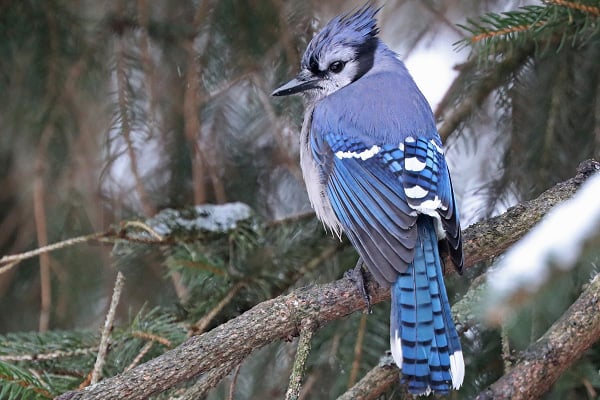
Identification and Recognizable Traits
Blue Jays are 22 to 30 cm long and weigh 70 to 100 grams. Their blue feathers look blue because of how light scatters off them. They make loud calls from trees that can be heard far away. When they’re with family or friends, they often lower their crests, showing they’re calm.
Behavior and Intelligence
Blue Jays live in complex social groups and have strong family ties. They show off their smarts in different ways. In the wild, they use tools to get food, like newspaper strips. They also cache food, storing it for later.
These birds are clever at mimicking hawk calls. This warns other Blue Jays of danger and can trick other birds. It’s a smart way to stay safe and communicate.
Final Thoughts…
We’ve explored the world of North American blue birds, focusing on the Eastern Bluebird, Mountain Bluebird, and Indigo Bunting. Each species has its unique traits and habitats. This makes our natural world richer and more diverse.
To attract bluebirds to your garden, try placing nesting boxes at 5-10 feet high. Keep areas with short grass open. Offer a mix of insects, berries, and fruits, and make sure there’s fresh water in a birdbath.
Creating a garden without pesticides and protecting nests from predators is also key. This makes your garden a safe place for bluebirds.

